The impact of cookie apocalypse on digital media
The current context is forcing digital marketers to navigate through a multitude of upheavals induced by the web giants which is affecting the very foundations of their everyday tasks. As described in part in this article by Jean-François Renaud, these changes respond to the growing demand for greater transparency from users when it comes to the use of their personal data, as well as for tighter control over its collection.
The public’s increased awareness of the power of personal data is forcing governments (such with the RGPD in Canada, the California Consumer Privacy Act in the U.S., and soon Bill 64 in Quebec) as well as the web’s giants (Google, Apple, Facebook, Amazon) to establish concrete measures to return control over personal data to users. Apple was amongst the first to take action, in 2017, with ITP (Intelligent Tracking Prevention) and, more recently, with the iOS 14 update (learn more about the specific effects of the latest iOS update on your Facebook campaigns here). Firefox quickly followed suit with its own proposition, ETP (Enhanced Tracking Protection). Although it should be said that at that time the industry did not react strongly to this news, since Apple and Firefox only represent around 23% of web users worldwide, and only 35% in Canada (market share trends for browsers are presented in the graph below).
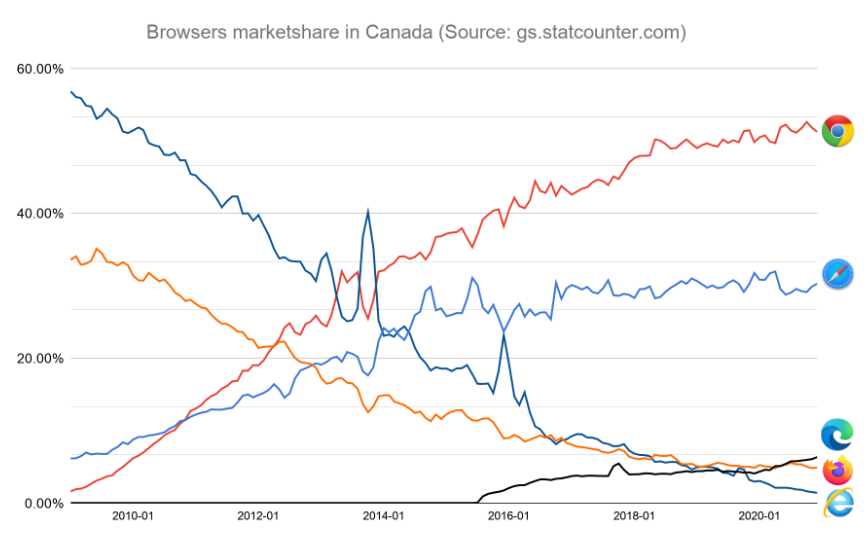
In January 2020, Google announced that it would end the use of third-party cookies in its browser, Chrome. This historic announcement marked an unprecedented turning point in the digital industry. Combined with the past actions of other big web players—and more actions to come—the entire manner in which we plan, execute and measure digital ad campaign effectiveness has been called into question. In this article, we will try to describe and democratize the effects of these transformations and present a few solutions for the short and medium term to help you better understand the breadth of the most sweeping transformation of digital media in the past 20 years. And help you prepare for it.
Before we get started: What is a cookie?
If you are already familiar with the concept, please skip to the next section, which covers the repercussions of the withdrawal of third-party cookies and the solutions proposed.
During the early days of the web, there was no way to trace users. It wasn’t until 1994 that Lou Montouli, an employee at Netscape, invented the HTTP cookie. The first actual use of cookies was to verify whether visitors of Netscape’s website had already visited the site in the past (Gartner).
But these days, what are cookies used for? They can be used to save items in your shopping cart while you make purchases online, or allow a site to remember your past choices, such as language preferences, user names and passwords. They can also collect information about the way you use the web, or even allow advertisers to display more relevant advertising and to measure their effect. It’s this last use case that will be of interest to us in this article.
Before going any further, it is, however, important to recall that there are two types of cookie:
- first-party cookies;
- third-party cookies.
Chrome ads affect only third-party cookies, while Safari’s ITP and Firefox’s ETP affect third-party AND first-party cookies. But how will it all actually work? (Clearcode, 2020)
User A visits Nike.com. A first-party cookie is stored under the domain name where the cookie was created: “Cookie domain: nike.com.”
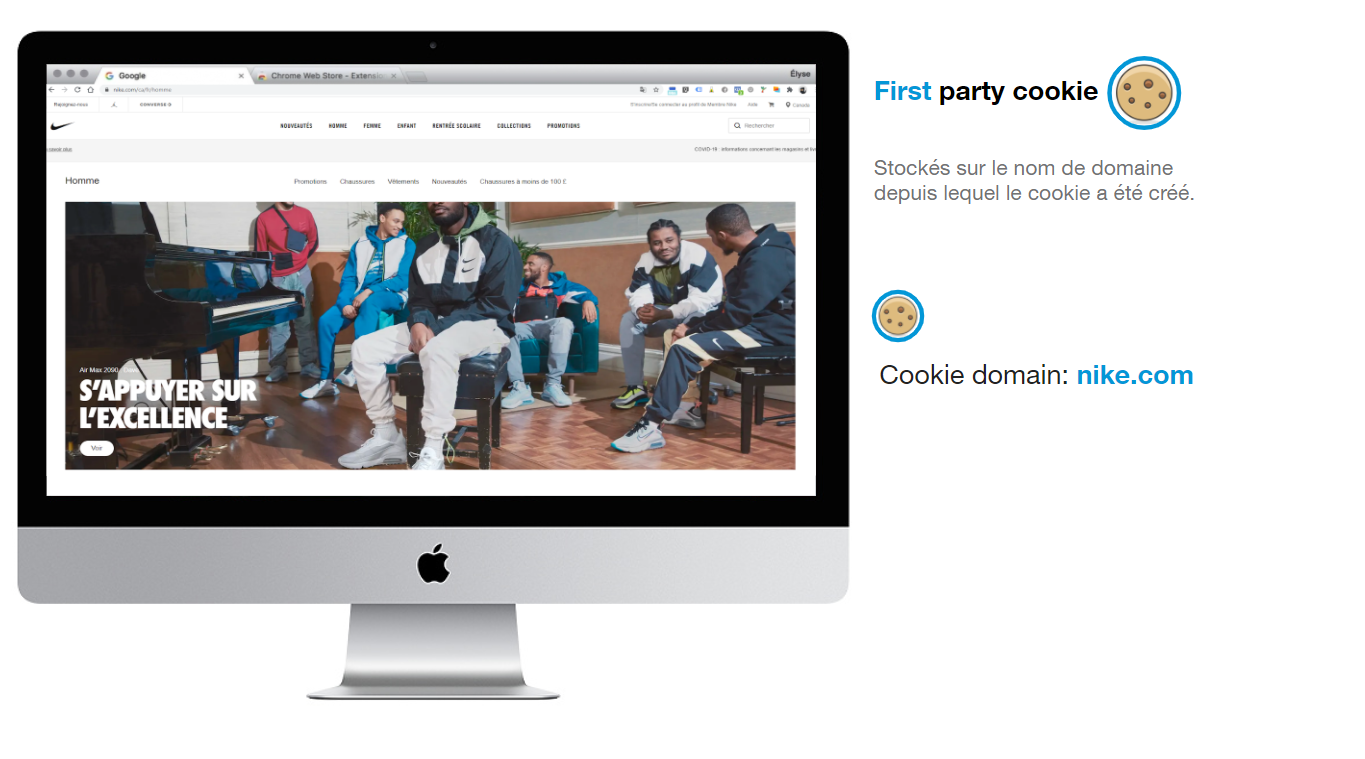
When the same user A goes to Nike.com, a third-party cookie is stored under the third-party domain name for advertising purposes: “Cookie domain: google.com.”
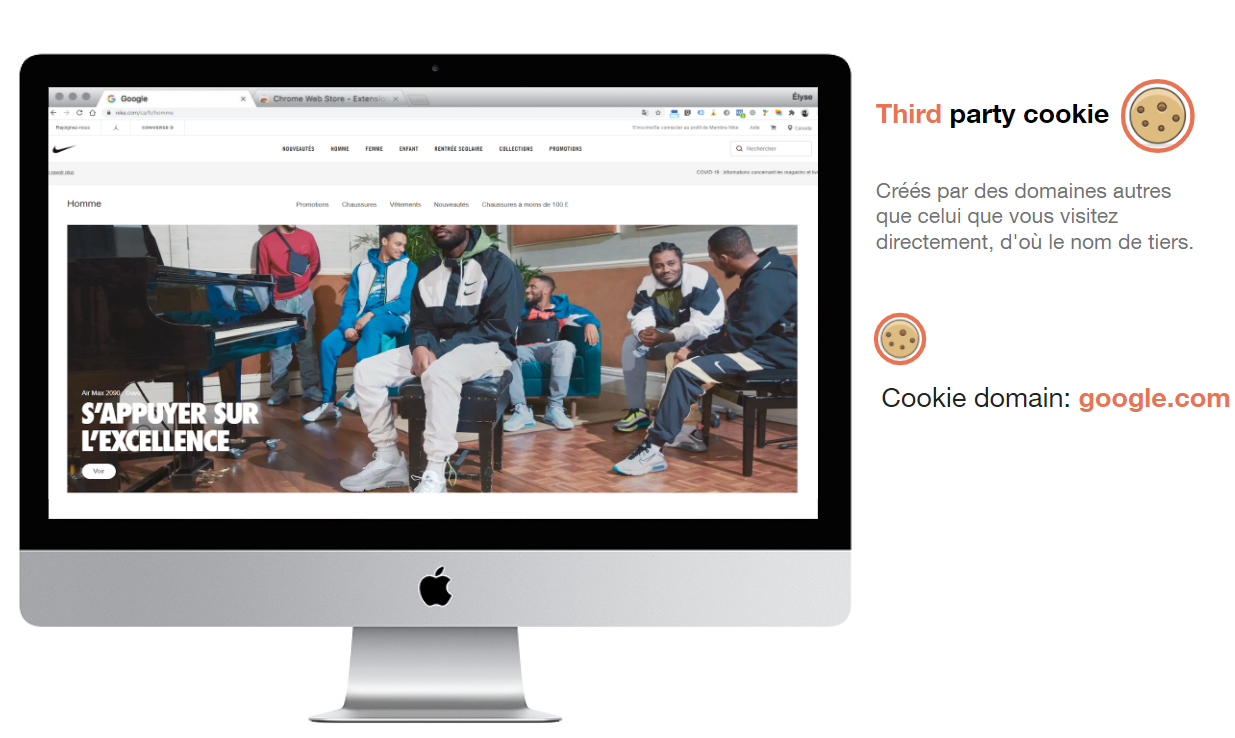
Now let’s look at an example where a user visits several domains.
User B goes to Nike.com, doesn’t find any shoes he likes, then decides to go to Adidas.ca.
In a first-party context, the cookie doesn’t know that user B changed domain names.
.png?width=1275&height=761&name=image6-2%20(1).png)
On the other hand, in a third-party environment, the third-party cookie knows that user B changed domain names.
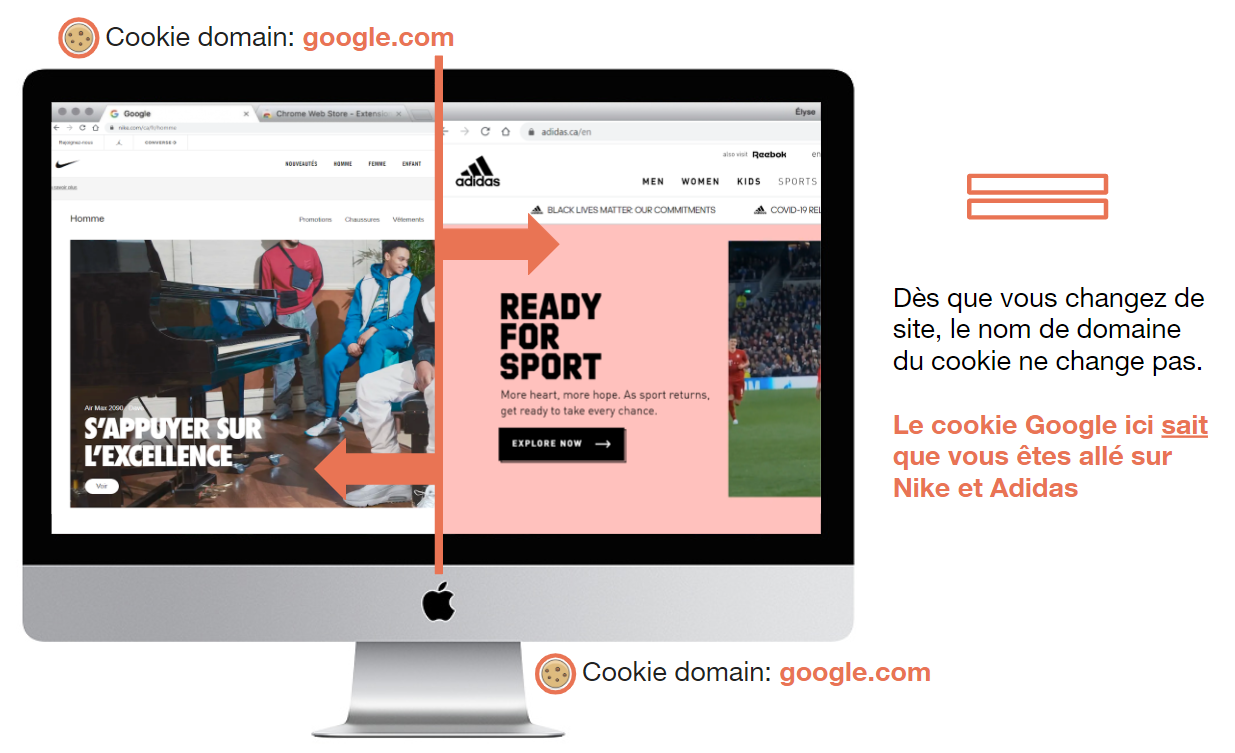
Our example uses only a single third-party cookie. What would happen if we reproduced this example with hundreds of third-party cookies?
By using the Lightbeam application, we can visualize the connections between the different third-party cookies based on the domains we have visited. We can see that after having visited 12 sites, a typical user would have close to 450 trackers installed in their browser. This would enable Ad-tech platforms to draft a specific profile of users by mapping all of their activities on the web.
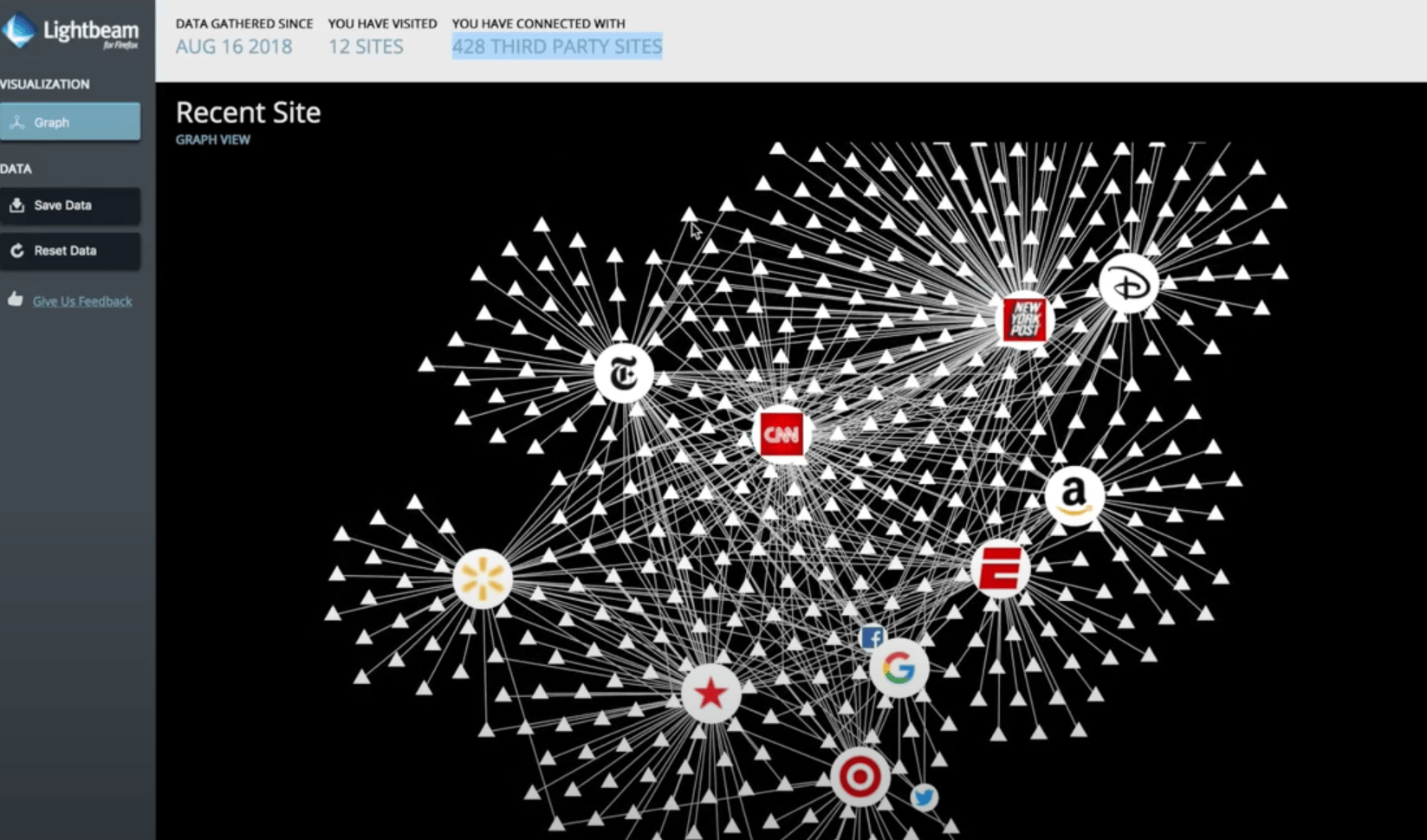
Today’s Internet, which is based on this implicit exchange of user data for free content, has gone too far (The Trade Desk, 2020). By looking at this simplified example, you can understand the desire to apply the brakes on what could be called the Wild West of third-party cookies. (Note: We could get into a debate on the apparent good faith of some actors, whose motivations seem to be more strategic, but this would take us beyond the scope of this article.)
In concrete terms, what effect will the disappearance of third-party cookies have on your digital marketing? Rest assured that the answer to this question is definitely coming. However, it’s important to be prepared for these disruptions beforehand. We will therefore present the possible repercussions under two aspects: measurement and attribution; and audiences.
Download our preparatory guide to the cookie apocalypse
Measurement and attribution
In digital media, what is meant by measurement? We refer here to the capacity to directly measure the performance of your campaigns on Ad-tech and analytics platforms by tracking conversions, whether they are:
- post-click: the user is converted after having clicked on an ad;
- post-view: the user is converted after having seen an ad.
For its part, attribution refers to the capacity to attribute the credit for a conversion entirely or partially to one or several channels or points of contact.
To put this in context, you need to understand that each type of conversion is measured within a defined time horizon. For example, Facebook attributes a conversion when a definite action, parameterized by the advertiser, is realized on the advertiser’s site or app by a user. This conversion is attributed 7 days after a click on a brand’s ad (or one day after having seen an ad, through this will not be the case for much longer given the changes in the platform related to iOS14).
A return to the “last click” model?
The ability to attribute an action made by a user relies on the storage of a third-party cookie on the device. After they disappear, how will platforms be able to attribute conversions related to views or clicks several days after an interaction? As of this writing, this seems very complicated, or even impossible. Furthermore, Facebook has recently announced the removal of several windows that measure conversions (Facebook, 2020). When reading this, your first reaction may be to completely revise your current attribution model and return to the good-old “last click” method (AdExchanger & Paparo, 2020). This might be a short-term solution, but note that the industry is heading in a different direction.
Conversion modelling
Currently the trend is moving towards conversion modelling to mitigate the loss of data (Google, 2020). Google, for its part, has integrated conversion modelling into Campaign Manager 360 since October 2020 (Google, 2020). The very idea of data modelling makes some marketers nervous, since they see it as a move away from the possibility of perfectly measuring all their “real” conversions. However, measurement and attribution have never been perfect: sampling, users coming from Safari or Firefox, cookie synchronization, scripts that don’t launch when the page is loaded, ad blockers… Already today there exist many factors that make measurement imperfect!
Is post-click and post-view attribution possible?
With its Privacy Sandbox, Google is developing new ways of measuring conversions without third-party cookies. These technologies should permit making information available at an “event” level to auction algorithms which detect trends in behaviour in order to capitalize on them. On the other hand, measurement and attribution data will be shared with advertisers in an aggregated format, with a certain level of noise and lag time, thereby allowing for relatively precise measurement while respecting users’ privacy (Google, 2021). At this time, tests are performed at the click level, but the model can be extended to impressions. It’s important to note here that these are propositions put forward by Google on Github using the open source model and there is no guarantee of future compliance by other browsers with this technology.
Don’t know where you get started with measuring your performance in 2021? Learn more by reading an article from our teammate Aurélie!
Audiences
What do we mean when we talk about audiences in digital media? These are groups of individuals with attributes that either closely or distantly relate them to your brand.
- Prospective audiences: Individuals who have no obvious relationship with your brand, but with whom you would like to start a discussion. These audiences are constructed using attributes that can be shared by advertising platforms (Google, Facebook), suppliers of third-party data (Bluekai, Exelate, etc.) or even from data partnerships between two entities (secondary data).
- Remarketing audiences: Individuals with a direct connection to your brand (visit to the website, interaction on social media, video views, purchases, etc.) and with whom you would like to continue the discussion. For the most part, these audiences are constructed using third-party pixels from purchasing platforms (which are now adapting by integrating new first-party functionalities) or even from email lists obtained through user consant.
The announced changes will have major repercussions on the way in which targeting works for these audiences today.
What are the current repercussions for advertising targeting?
The effects are already being felt: iOS/Safari and Firefox users who now have more control over their personal data are harder to target. They are no longer (or are much less) traceable by third-party cookies, and we might even go so far as to qualify these audiences based on obsolete third-party cookies. Thus, advertisers using third-party audiences created in Ad Server or a DSP/DMP should take into account the percentage of traffic coming from these sources, especially when they plan to target audiences based on events within a predetermined time frame (for example, abandoning a shopping cart after 5 days), because the composition of these audiences is affected. Planners should also avoid buying audiences supplied by third-party resellers if the majority of their traffic comes from iOS/Firefox, because theoretically these audiences contain zero percent of users from these browsers.
Those who can be considered to be playing their cards right are entities that own their own data. Whether through their service offering or business model, players such as GAFA own their audience data. Google always knows what its users are doing on all of its properties (search engine, browser, YouTube, Gmail, Fitbit). The audiences offered by GAFA will therefore effectively always be of higher quality. For this reason they should be preferred, to the detriment of data supplied by third-party providers available through various DMPs. These third-party data providers will either need to reinvent themselves or disappear, since their business models have been put in danger by the current disruption. This quasi-monopolistic hegemony of the web giants will only intensify.
The future of targeting by interest using third-party cookies
What the future will look like is slowly taking shape. With Google’s announced withdrawal of third-party cookies from its browser by 2023, we’ve seen a wellspring of alternative propositions to the current situation arise. Thus, targeting by interest cohorts (FLoC), as put forward by Google, will materialize in 2021 (Google, 2021).
In concrete terms, to replace cookies, Google is proposing a system called FloC (Federated Learning of Cohorts). This system relies on cohorts of users shaped by an individual classification system based on visited sites. These data on interests would be stored on the browsers of users, who would then have the ability, as they do now, to see and verify the interest cohorts in which they find themselves placed.
The system would collect information relating to user interests by way of an algorithm that would analyze the content of a site visited by a user and then place the user amongst a cohort who share the same interest. The interests would be identified according to the sites or sections of sites that the users visited. The big difference between this proposal and the use of third-party cookies lies in the way in which the users are identified, that being within the context of a cohort and not individually. To prevent a scenario in which a person can be identified by the cohorts they belong to, certain of the user’s cohorts would be replaced by cohorts selected at random in order to add noise to the data and make the user unidentifiable (WICG, 2021).
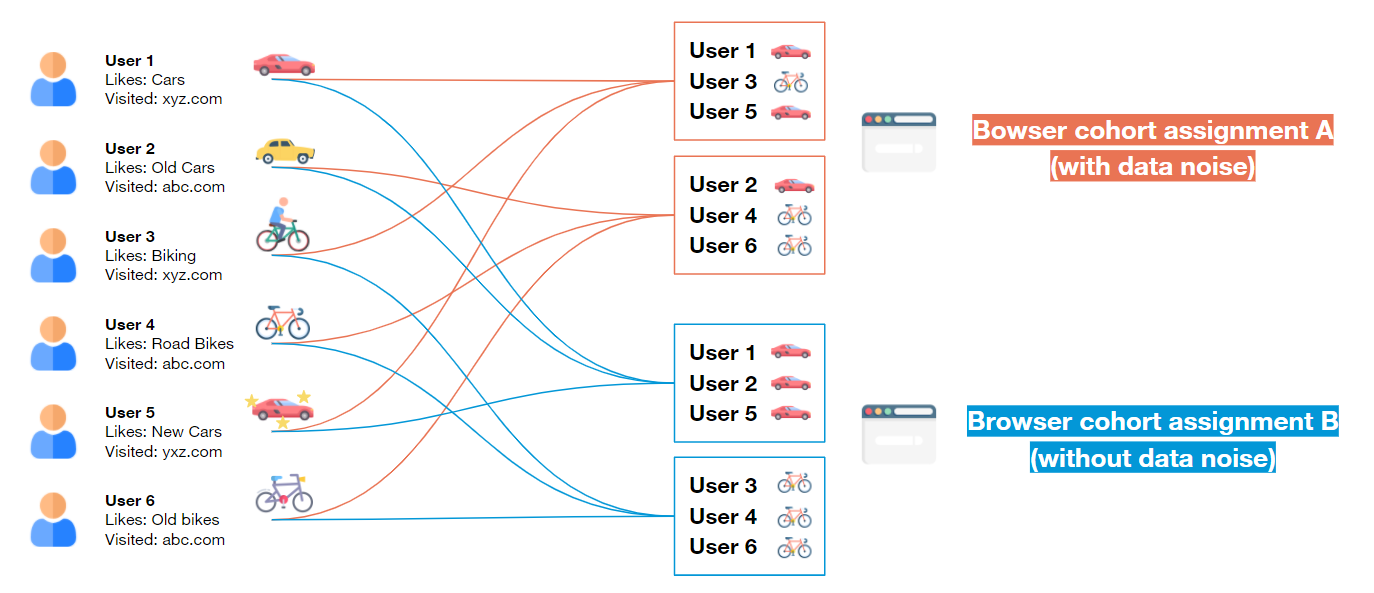
The entities that can create interest cohorts will be:
- Advertisers: The may create and own interest groups composed of people who, in their opinion, are interested in their products (a classic remarketing case is detailed later in this article).
- Publishers: They may create and own interest groups composed of people who have read a certain kind of content on their site.
- Third-party advertising technology companies: They may create and own an interest group composed of people who, in their opinion, are in the market for a certain category of good (WICG, 2021).
FloC cohorts will be available in Q2 on Google Ads. The preliminary results show an effectiveness of 95% per dollar invested, compared to advertising based on third-party cookies (Google, 2021).
A big comeback for contextual targeting?
Amongst other solutions, the return of contextual targeting is one possibility. When advertisers have high-quality data on the media consumption habits of their targets, these placements often perform very well, especially for ensuring a continual presence in the minds of their potential targets (as part of a brand or consideration campaign, for example).
Unfortunately for publishers, who are already suffering a lot from the growing dominance of the big players on the web in terms of volume of advertising investment, more pain is on the horizon. Basically, the disappearance of third-party cookies has brought about the end to using and reselling third-party audiences, which are often mixed with publishers’ owned audiences to enrich performance. Publishers will therefore have to increase their ability to harvest first-party data to survive, since without this their advertising revenue, which was already affected by the rise of the big players, is at risk of being reduced even more. This is the reason behind the creation of Unified ID 2.0 by The Trade Desk and Liveramp. The idea is to allow all publishers participating in the initiative to share audience data based on encrypted, hashed email messages to create a replacement of the third-party cookie identity standard (Ad Exchanger, 2020).
In Quebec, La Presse recently announced a partnership with Mediarithmics to enrich its readers’ first-party data as far as possible in order to continue to offer high-quality audiences to advertisers (Media in Canada, 2020).
How might retargeting work without third-party cookies?
Advertisers must find other means of identifying users, for example by obtaining their email addresses and by encouraging them to identify themselves during visits to their sites. This might seem complicated, but value exchange with users is a new trend in the industry (Gartner, 2020). It’s no longer a question of simply taking the data and using them—you have to offer value in returns. A good example of a creative execution is provided by Mondelez, which developed a first-party data acquisition strategy by emphasizing value exchange. With their Make Your Sour Patch Mix platform, customers can select their candy and its packaging, and even add some personalization (Google, 2020).
“When consumers come to us to share their personal information, we match that by ensuring a very high standard in terms of the value they receive in return.” – Jonathan Halvorson, Global Vice-President, Mondelez International
As with targeting by interest, Google is currently looking for safer, more transparent alternative solutions for user data— that are also open source—in order to give advertisers the ability to create audiences from visitors without using third-party cookies. Google’s FLEDGE (First Locally-Executed Decision over Group Experiment), developed as a result of their previous proposal called TURTLEDOVE (Two Uncorrelated Requests, Then Locally Executed Decision On Victory) and the contribution of a few major Internet actors such as Criteo (SPARROW) and RTB House (Outcome-Based TURTLEDOVE), promises to work according to the same logic as FLoC (Google, 2021). Users visit, for example, an advertiser website, are placed in an interest cohort with a minimum volume of users (in this case, visitors to the advertiser’s site) and this same advertiser would be able to target this cohort or even exclude it during its advertising campaigns.
Once on a publisher’s site, the Fledge API would permit the display of:
- an ad related to the page visited (for example, ad for a ready-to-wear clothing brand);
or an ad relating to a specific cohort to which the user belongs (such as an ad for a new vehicle).

It is very important to note that these solutions are still in the proposal stage and there are no guarantees with regard to whether other browsers will eventually support them.
Conclusion
The major changes initiated by big web players and governments, influenced by user demand for better control over their personal data, are shaking up the advertising activities of a large majority of advertisers and publishers, and will continue to do so. Measuring the effectiveness of advertising campaigns, the capacity to attribute results directly to advertising activities, and the ability to precisely target users will all entirely change.
In addition to these considerations, advertisers and publishers who harvest browsing data must in the near future ensure they are collecting a large quantity of data—legally. More and more governments are drafting legislation around data collection and obliging advertisers and publishers to ensure the explicit consent of users to collect their data.
In responding to these changes, advertisers and publishers must ensure they begin and maintain relationships based on high-quality content availability and transparency with regard to their use of personal data if they want to gain users’ trust. The latter, on the other hand, will be able to better understand how their data is used and its actual value.
Visit our special section dedicated to the Cookie Apocalypse to learn more about it
Bibliography
%20(1)-1.jpg)

-1.png)











